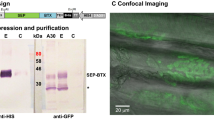Abstract
SEVERAL, inorganic cations are important in the liberation of acetylcholine during neuromuscular transmission. Extracellular calcium ions are essential for the transmitter release during the depolarization of the nerve terminals1. The mean number of packets of transmitter liberated (quantal content m) depends on the external concentration of calcium2. In this process magnesium ions compete with calcium ions3. Extracellular sodium ions also take part in the process of transmitter release by the nerve impulse. A reduction in the extracellular sodium concentration produces a large increase in the end-plate potential amplitude, and in m, at least under conditions of low external concentrations of calcium (refs. 4 and 5).
This is a preview of subscription content, access via your institution
Access options
Subscribe to this journal
Receive 51 print issues and online access
$199.00 per year
only $3.90 per issue
Buy this article
- Purchase on Springer Link
- Instant access to full article PDF
Prices may be subject to local taxes which are calculated during checkout
Similar content being viewed by others
References
Katz, B., and Miledi, R., Proc. Roy. Soc., B, 167, 8 (1967).
Katz, B., and Miledi, R., Proc. Roy. Soc., B, 161, 496 (1965).
Jenkinson, D. H., J. Physiol., 138, 434 (1957).
Birks, R. I., and Cohen, M. W., in Muscle (edit. by Paul, W. H., Daniel, E. E., Kay, C. M., and Monckton, G.), 403 (Pergamon Press, 1965).
Kelly, J. S., Nature, 205, 296 (1965).
del Castillo, J., and Katz, B., J. Physiol., 124, 553 (1954).
Dodge, F. A., and Rahamimoff, R., J. Physiol., 189, 90 (1967).
Dodge, F. A., and Rahamimoff, R., J. Physiol. (in the press).
del Castillo, J., and Katz, B., J. Physiol., 124, 560 (1954).
del Castillo, J., and Katz, B., J. Physiol., 128, 396 (1955).
Takeuchi, A., and Takeuchi, N., J. Physiol., 154, 52 (1960).
Author information
Authors and Affiliations
Rights and permissions
About this article
Cite this article
RAHAMIMOFF, R., COLOMO, F. Inhibitory Action of Sodium Ions on Transmitter Release at the Motor End-plate. Nature 215, 1174–1176 (1967). https://doi.org/10.1038/2151174a0
Received:
Issue Date:
DOI: https://doi.org/10.1038/2151174a0
Comments
By submitting a comment you agree to abide by our Terms and Community Guidelines. If you find something abusive or that does not comply with our terms or guidelines please flag it as inappropriate.



